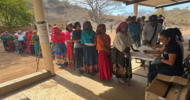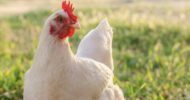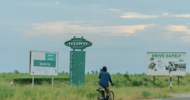Business News Europe | October 5, 2009
Nicholas Watson in Geneva
It isn't often you sit down with a fund manager and begin the interview by discussing their new film. But then John Coast Sullenger, managing director of GAIA Capital Advisors, is a fund manager who's following a very distinct investment theme: that there's a global food crisis and investors can profit from the new "Green Revolution" that will need to occur to solve this problem.
After the trauma of the financial crisis and the resulting economic crisis, people are heartedly sick of that word. Yet the food crisis that was exercising the minds of the world's policymakers and investors toward the end of 2007 never went away, but has been merely overshadowed by the two more well-publicised ones. That food crisis saw prices for grain set an all-time high on the Paris commodities exchange in September 2007, causing a spike in food prices and inflation that forced countries like Russia, Kazakhstan and Ukraine to impose price controls on basic foodstuffs to prevent food riots from spreading.
It was against this backdrop that Sullenger and his investment firm decided to sponsor the documentary film, "Last Supper for Malthus", directed by Klaus Pas and produced by Turbulence Films, which explores the drivers behind the food crisis and some solutions of how to solve it. The film's premiere was on September 21 and it will be screened at various film festivals over the coming months (to see the preview, click here). "We were inspired to produce this documentary because the issue surrounding the food crisis, the drivers behind it, are quite complex and remain misunderstood by the population at large," says Sullenger. "We sponsored the production of this film with the main objective to create awareness about the key drivers of food crisis, but do it in a way that is both captivating and entertaining."
The film took over 12 months of research, interviews and filming, conducted around the world in places like Brazil, Ukraine, India, China, the US and Liberia. "We wanted to produce a reference work that assembles different points of view from the right – industrialists and financial people – but also from the left-orientated groups like anti-GMO groups. The film has no particular bias, it's very objective [and] we think we achieved something quite compelling and innovative," Sullenger says.
That said, the film's highlighting of the fundamentals behind the food crisis also serves to get across the investment theme behind the Geneva-based GAIA Capital's World Agri Fund, a $15m open-end fund which invests in listed and pre-IPO global agriculture-related companies. On the demand side, there are the two factors of population growth and wealth effects - diets are evolving to include more animal proteins. Given there are now almost a billion people who go to bed hungry every night, clearly the world needs to produce more food. "If we continue to consume grain like we have over the last five years, the stocks/use ratio will continue to decline. So instead of having 100 days of consumption in stock, we will see that go down to 50 days or even 30 days. We are in a very delicate situation and production needs to increase," Sullenger says.
However, on the supply side, the amount of extra arable land in the world that can be put into production is only another 3%, so the only way to increase production is to raise the amount of crop produced per hectare. This can be achieved through another so-called "Green Revolution", the post-war change in agriculture practices that allowed food production to keep pace with worldwide population growth. "Today, we stand on the brink of new Green Revolution that we think must come from pure necessity to produce more for the growing population. And that revolution will bring capital to new technologies, bring capital into all the inputs of production – pesticides, tractors, fungicides, modern equipement, infrastructure.... We want exposure to all those industries, everything that's related to agriculture," says Coast.
So in blue-chip stocks, that would include companies like Monsanto, John Deere and Syngenta; in mid caps, Hanfeng Evergreen and Kernel Group; in small caps, Astarta-Kyiv and Black Earth Farming. "Our universe consists of over 1,00 companies that have exposure to agriculture," Sullenger says.
Cheaper in the east
In terms of geography, GAIA finds Eastern Europe a particularly interesting area, because it's one of the few areas on earth where there's a large availability of arable land that's under-producing or not in production - a legacy of the Soviet collective farm system, which left farms in a very poor state of repair and lacking capital and expertise. "Talking about Eastern Europe, Russia and Ukraine, it's very similar to where Latin America, specifically Brazil and Argentina, was 15 years ago, so growth opportunities are tremendous," he says. "Those who invested early in Brazil and Argentina reaped huge rewards."
As an example, he adds, the harvest yields in Eastern Europe average around 2 tonnes of grain per hectare, despite having some of the most fertile land in the world - the black earth, or Chernozem, soil belts found in Eastern Europe and North America have extremely high humus content - so it is a question of a lack of modern inputs and capital today. "The harvest yields in this region can triple in the next 10 years or so - this is a significant growth opportunity!"
Additionally, investors can take advantage of the predicted land grab by Middle Eastern and Asian governments looking to secure food supplies (in a neat mirror image of the West's quest to securing energy supplies). In Argentina, the cost of farmland is about $8,000 per hectare, whereas in Russia it's less than $800. The reason for the huge discrepancy in valuations is that in Russia there isn't the same availability of service providers. "If you're a farmer in Russia, you have to own the equipment, you can't rely on outsourced harvesting or the price is simply too high. You have to also own the storage capacity, otherwise you'll get very bad pricing at the farm gate. These are just a couple of issue investors have to deal with in that region," says Sullenger.
Elsewhere in the former Soviet Union, GAIA is also looking at Kazakhstan, however investing in the near term would be hard because there are so few listed companies to get exposure. "We're aware of [Kazakstan's potential] and in contact with certain companies there which have the potential to be listed in future, so we may buy them pre-IPO," he says.












